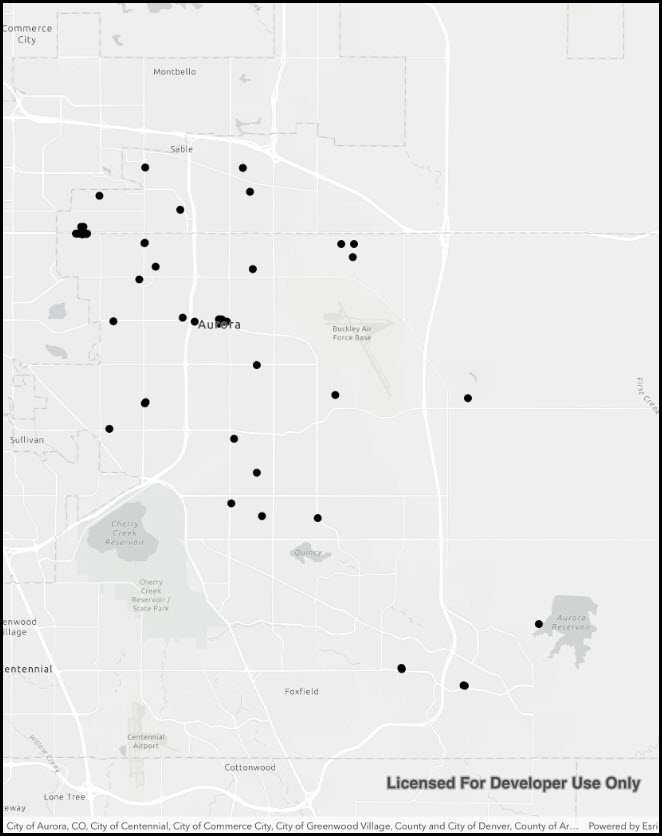Display features from a local GeoPackage.

Use case
A GeoPackage is an OGC standard, making it useful when your project requires an open source data format or when other, non-ArcGIS systems may be creating the data. Accessing data from a local GeoPackage is useful when working in an environment that has an inconsistent internet connection or that does not have an internet connection at all. For example, a department of transportation field worker might source map data from a GeoPackage when conducting signage inspections in rural areas with poor network coverage.
How to use the sample
Pan and zoom around the map. View the data loaded from the geopackage.
How it works
- Create a
GeoPackagepassing the URI string into the constructor. - Load the
GeoPackagewithGeoPackage.loadAsync - When it's done loading, get the
GeoPackageFeatureTableobjects from the geopackage withgeoPackage.getGeoPackageFeatureTables() - Create a
FeatureLayer(featureTable)for each feature table and add it to the map as an operational layer. Add each to the map as an operational layer withmap.OperationalLayers.Add(featureLayer).
Relevant API
- Map
- FeatureLayer
- GeoPackage
- GeoPackageFeatureTable
Offline data
This sample downloads the following items from ArcGIS Online automatically:
- Aurora, Colorado GeoPackage - GeoPackage with datasets that cover Aurora Colorado: Public art (points), Bike trails (lines), and Subdivisions (polygons), Airport noise (raster), Buildings (raster).
Tags
feature table, geopackage, gpkg, OGC, package, standards
Sample Code
// Copyright 2017 Esri.
//
// Licensed under the Apache License, Version 2.0 (the "License"); you may not use this file except in compliance with the License.
// You may obtain a copy of the License at: http://www.apache.org/licenses/LICENSE-2.0
//
// Unless required by applicable law or agreed to in writing, software distributed under the License is distributed on an
// "AS IS" BASIS, WITHOUT WARRANTIES OR CONDITIONS OF ANY KIND, either express or implied. See the License for the specific
// language governing permissions and limitations under the License.
using System;
using System.Linq;
using ArcGISRuntime.Samples.Managers;
using Esri.ArcGISRuntime.Data;
using Esri.ArcGISRuntime.Mapping;
using Esri.ArcGISRuntime.UI.Controls;
using Foundation;
using UIKit;
namespace ArcGISRuntime.Samples.FeatureLayerGeoPackage
{
[Register("FeatureLayerGeoPackage")]
[ArcGISRuntime.Samples.Shared.Attributes.OfflineData("68ec42517cdd439e81b036210483e8e7")]
[ArcGISRuntime.Samples.Shared.Attributes.Sample(
name: "Feature layer (GeoPackage)",
category: "Data",
description: "Display features from a local GeoPackage.",
instructions: "Pan and zoom around the map. View the data loaded from the geopackage.",
tags: new[] { "OGC", "feature table", "geopackage", "gpkg", "package", "standards" })]
public class FeatureLayerGeoPackage : UIViewController
{
// Hold references to UI controls.
private MapView _myMapView;
public FeatureLayerGeoPackage()
{
Title = "Feature layer (GeoPackage)";
}
private async void Initialize()
{
// Create a new map centered on Aurora Colorado.
_myMapView.Map = new Map(BasemapStyle.ArcGISLightGray);
_myMapView.Map.InitialViewpoint = new Viewpoint(39.7294, -104.8319, 175000);
// Get the full path.
string geoPackagePath = DataManager.GetDataFolder("68ec42517cdd439e81b036210483e8e7", "AuroraCO.gpkg");
try
{
// Open the GeoPackage.
GeoPackage geoPackage = await GeoPackage.OpenAsync(geoPackagePath);
// Read the feature tables and get the first one.
FeatureTable geoPackageTable = geoPackage.GeoPackageFeatureTables.FirstOrDefault();
// Make sure a feature table was found in the package.
if (geoPackageTable == null)
{
return;
}
// Create a layer to show the feature table.
FeatureLayer newLayer = new FeatureLayer(geoPackageTable);
await newLayer.LoadAsync();
// Add the feature table as a layer to the map (with default symbology).
_myMapView.Map.OperationalLayers.Add(newLayer);
}
catch (Exception e)
{
new UIAlertView("Error", e.ToString(), (IUIAlertViewDelegate) null, "OK", null).Show();
}
}
public override void ViewDidLoad()
{
base.ViewDidLoad();
Initialize();
}
public override void LoadView()
{
// Create the views.
_myMapView = new MapView();
_myMapView.TranslatesAutoresizingMaskIntoConstraints = false;
View = new UIView() { BackgroundColor = ApplicationTheme.BackgroundColor };
// Add the views.
View.AddSubviews(_myMapView);
// Lay out the views.
NSLayoutConstraint.ActivateConstraints(new[]
{
_myMapView.TopAnchor.ConstraintEqualTo(View.SafeAreaLayoutGuide.TopAnchor),
_myMapView.BottomAnchor.ConstraintEqualTo(View.BottomAnchor),
_myMapView.LeadingAnchor.ConstraintEqualTo(View.LeadingAnchor),
_myMapView.TrailingAnchor.ConstraintEqualTo(View.TrailingAnchor)
});
}
}
}